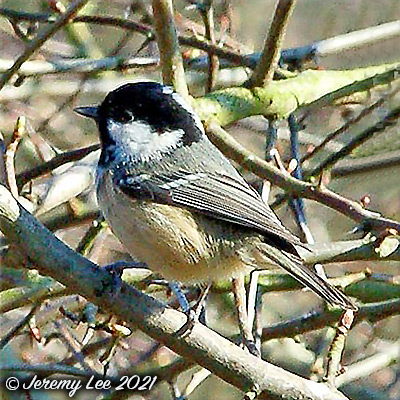
 |
|
Scientific Classifications explained » Amphibians » Ants » Aphids » Bees » Beetles » Birds » Bugs » Butterflies » Caterpillars » Damselflies » Dragonflies » Earwigs » Flies » Frog/Leafhoppers » Fungi » Galls » Grasshoppers » Harvestmen » Hoverflies » Lacewings » Ladybirds » Leaf Mines » Lichens » Mammals » Millipedes » Mosses » Moths » Sawflies » Slugs » Snails » Spiders » Trees & Shrubs » Wasps » Wild Flowers » Woodlice » Postboxes |
UK Nature > Birds > Periparus ater

Scientific Name: Periparus ater Common Name: Coal Tit Periparus ater, more commonly known as the Coal Tit, is approximately 12cm in length, having a black crown and throat, white sides to the face and a white nape. Wings are a mid grey with two white marks and the undersides a dirty off-white. They have a wide range of calls, many of which are superficially similar to those of the Great Tit (Parus major), the commonest being a bell-sounding "teacher-teacher-teacher". Omnivorous, usually searching for insects and spiders in the trees and for seeds on the ground, and not such a common visitor to bird tables and feeders as Blue and Great Tits. Usually nests in some sort of hole, very much like a Blue Tit (Cyanistes caeruleus), although will use nestboxes on occasion. Found throughout the UK in woods, parks and gardens, especially those containing conifers. Historically only a garden visitor in winter, but from personal experience this seems to be changing somewhat. |
|

https://www.uknature.co.uk is a website dedicated to showing the immense diversity of UK nature and wildlife. Our vast range of habitats, from lowland arable to snow covered mountains, from storm-ravaged coastlines to peaceful inland freshwater lakes and rivers, from dry, sandy heaths to deciduous and coniferous forests, all these habitats contribute to the abundance of UK nature. We have wild birds in huge numbers either residing or visiting our shores (597 recorded species as at July 2013) and we must also not forget the humble back garden with its grass lawns, flower beds filled with nectar rich flowers, shrubs and trees, all designed to attract huge numbers of insects such as bees, moths, butterflies and hoverflies; and finally the small ponds which provide safe havens for frogs, toads, newts and even slow worms and grass snakes. www.uknature.co.uk is the showcase for my personal passion, photographing uknature in all its glory. I sincerely hope you all enjoy the fruits of my labours. This site and all images contained therein is © Jeremy Lee 2004 - 2025. All Rights Reserved. Site design by Jeremy Lee. Site development & IT Support by Stuart Lee. |